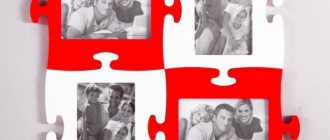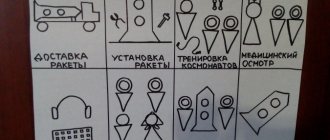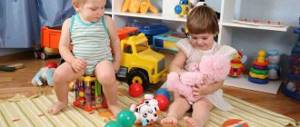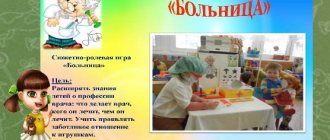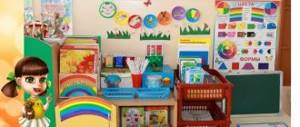From the moment a baby is born, play occupies a special place in the process of raising and developing the baby. It is in the process of play that the little person gains knowledge that will help the child socialize and develop communication skills.
Games at an early age are the main source of information about the world around them; they promote the child’s sociability, develop attentiveness, memory, and logical thinking. For every age of a child, there are games that allow you to learn new skills and abilities. After the birth of the baby, the mother already entertains the child: she moves her fingers, moves a rattle in front of the baby’s eyes.
The concept of gaming activity
Until recently, it was believed that a game was an activity used for entertainment that had no practical use. This activity was considered pampering, fun. In the theory of modern psychoanalysis, this fun is given a special place in the education of the younger generation, its intellectual and physical development.
Play is a fundamental activity for children, a way of understanding reality, one of the main forms of development of the mental functions of a person’s personality. The child plays because he is interested in the process itself; the child does not pursue any visible goal.
Children imitate adults, trying to reproduce and repeat adult life in a conventional, imaginary world. An animal, like a person, learns and develops when it plays. In this, the animal and human worlds are similar.
The baby shows his abilities, learns to interact with other people, take initiative, and find a way out of any difficult situations. The fool is preparing to enter adulthood.
The terms “game” and “game activity” are interrelated. Gaming activities promote optimal assimilation and consolidation of various information obtained during the game. The development of play activities has the most positive impact on the upbringing of children.
The functions inherent in this type of activity help the little man to more fully reveal his abilities. For adults, assistance is provided to correct the development of fidgeting. Functions are divided into the following types:
- entertainment is one of the important functions. Arouses the baby's interest, entertains, and gives pleasure;
- the sociocultural function helps to instill in a foolish child the skills of moral behavior, introduces him to the basic rules of life in the surrounding society;
- The diagnostic function helps an adult to promptly recognize deviations from the norms of development and behavior of the baby. The baby himself can get to know himself and his capabilities better;
- correctional, with the help of which you can influence the foolish to make positive changes in the baby’s personal structure;
- therapeutic teaches in an entertaining way to overcome various life difficulties in other activities, such as training, work;
- communicative develops the ability of foolish children to communicate, receive, and transmit information in the process of joint activities with peers and adults, develops the speech of the foolish child;
- The educational - cognitive function consolidates the huge layer of information received by the baby in the game. Develops curiosity and desire to acquire new knowledge;
- The child’s self-realization is manifested when the child chooses a role. Leader or follower, the teacher will immediately note the demonstrated qualities of the baby.
The baby will not play if he is bored or uninterested. Only with the voluntary consent of the baby to participate in the game process will all functions work fully. It is then that the baby learns generally accepted human values, moral skills, and is included as a full-fledged person in all social relations.
How are games chosen?
When choosing, they take into account the characteristics of the group in the kindergarten, age, level of development, even the weather. During the warm season, active outdoor activities are optimal. In bad weather, it is better to make up for the lack of physical activity in the kindergarten building, and outside - ask riddles, learn songs, play “Camera” or “Mirror”.
The game form is the best option for any activity. Kids are much more willing to engage in sports, creativity or study if it is presented to them as games. That is why maximum attention is paid to entertainment in kindergartens.
To the list of articles
Types of gaming activities
A person’s entire life is accompanied by three main types of activity: play, learning, and work. As a person grows older, they replace each other. The play activity of preschoolers is the initial stage in the process of forming the child’s personality as an independent subject of activity.
The success of play activity determines how the baby will grow up, how his abilities will develop, and how successfully the baby will join the learning process. Education prepares children for work, the main activity of an adult. The types are divided according to the age characteristics of the children:
- activities of preschoolers;
- for children of primary school age;
- for teenagers;
- trainings.
According to the form of children's activity and the role of adults:
- independent, where the initiative, independence, and activity of the children come to the fore. The adult does not interfere with the gameplay. Children choose the game themselves, independently formulate its goal, and decide how and in what way to achieve the result. This includes educational and story-based activities that develop children’s thinking;
- training sessions that involve the presence of adults. A parent, educator, teacher explains the rules to fidgets, monitors the correctness of their observance, and coordinates the process of achieving results. The purpose of educational games is the education, training, and development of the foolish child. This includes all didactic, active, musical, constructive games;
- folk, arising from the historical traditions of the people. Adults, as well as older children, can be initiators here. These are mainly musical, staged games.
Types and forms of play activities in preschool age
The stages of development of the play activity of a preschooler provide enrichment of the types and forms of children's activities throughout the age period. If kids play more with simple toys and objects, then older preschoolers build the plot of the game, develop rules, and create entire projects for collective entertainment.
If we present a brief description of the gaming activity of preschoolers, it should be noted that at this age games differ in content, in the logic of actions, in the presence or absence of rules, and in the nature of roles.
Some types may require the child’s motor activity, while others may require the activation of mental processes. But each game situation has a modeling character, since children create a model of what they observe around them.
Subject game actions
This type is typical for very young children. During this period, play actions consist of copying the actions of adults. Such imitation games involve cooking, talking on the phone, and simulating other simple situations.
Substitute objects act as objects. The girl puts the doll to sleep in the same way as her mother does, and puts a toy phone or an object that resembles it in its shape to her ear. This format of play prepares the child for more complex types, promotes understanding that there are certain rules, and is the basis for future role-playing activity.
Outdoor games
Full development requires a sufficient amount of physical activity in a child’s life. Regular exercises are unlikely to interest your baby, but outdoor games are a great way to run and jump while having fun.
Traditional games involving movement have been around for centuries. These are tags, cat and mouse, bouncers. For groups of children there are games according to the rules. The latter become more difficult depending on the age of the players.
The most famous varieties involve the need to take a free place, catch the remaining one, and run to the “house” on command. In addition to the necessary physical activity, excitement is awakened in the process, a competitive effect arises, teaching the child to achieve a goal.
Role-playing game
The first role elements appear in a child at the age of 3, when he tries on someone else’s image - a doctor, a mother, a salesman. As children grow older, gaming activities become more complex: a plot appears, new players are added, and clear rules of the game are developed.
It is this form that relates to the child’s main activity. It can last a few minutes or last for days, when the girl imagines herself as a princess or heroine, and the boy strives to become a pirate, a superhero, or a great robber.
Role-playing activities most contribute to the development of imagination and creative abilities: even if a fairy tale or cartoon is taken as a basis, the plot is carefully reworked, new characters may appear, and the development of events often goes far away from the original outline.
Cognitive gaming activity
Playful activity helps the child master new knowledge and understand processes unfamiliar to him. Cognitive interest pushes many preschoolers to understand those actions of the adult world in which quite accessible tools are used.
The mechanism is as follows: the child saw a salesman or parents weighing food in a supermarket. Or watches how builders use a tape measure to measure the length or height. Interest in these activities encourages the child to master them independently.
Taking a ruler in his hands, he can measure all the items in the house, and if there are scales, then find out the number of grams of all the contents in the refrigerator. Despite the fact that everything happens within the framework of entertainment, the child acquires skills and gains knowledge that will be useful in the future in educational and professional activities.
Manifestation of activity of preschool children
In early childhood, a toy is of great importance to a foolish child. With the help of rattles, cubes, and balls, the baby already receives information about colors and shapes. The baby develops a perception of the world around him. When communicating with babies, parents should not only talk, but also show toys and unfamiliar objects.
Toys can be divided into several types:
- ready-made toys - cars, soft toys, dolls;
- those that require the participation of children. These are various types of construction sets, coloring books, cubes, puzzles;
- materials for children's creative expression. These include sand, plasticine, special dough, and water.
All toys help the baby to express himself more fully and develop creativity in children.
Perception and knowledge of the world by infants occurs through tactile sensation. It is important for the baby to touch everything with his hands and taste it. A foolish child should not be given toys with small parts that the baby can swallow or put in his nose. Don't leave your baby alone unattended.
The so-called director's perception of the world is the very first to be formed. Any item has a special meaning for the baby. For a simpleton, toys are models of the world of adults. Children develop their imagination. The little one plays with a cube, imagining that it is a real car. The girl feeds the dolls, dresses them up, puts them to bed, and imagines herself as a mother.
Toys help children perceive the world around them. Almost simultaneously, figurative role-playing moments arise. The little one depicts what he saw. The baby can imagine himself as an airplane or a dog. Such fun, as a rule, is short-lived, but it is they that will become the basis for more complex plot activities in the future.
By the age of 3, a fidget has a desire to play with peers, in a team. The kids really like active activities, such as “catch-up” and hide-and-seek. The kids are already trying to design something, for example, build a tower. Children begin to enjoy story-based role-playing games.
Playful activities of preschoolers help develop creative and organizational abilities. Fidgets play at school, at the hospital. They pretend to be firefighters or pilots. In gaming activities, a goal already appears that fidgets want to achieve.
Preschoolers are already choosing play activities with rules. The main thing is to comply with special rules. Usually these are team, competitive: sports or printed, board games. Preschoolers learn to put the interests of the team above personal interests.
Preschool age is the time of transition to learning activities. Didactic exercises begin to play a major role. Didactic classes allow you to consolidate learning tasks using gaming activities. Teach kids to count and form words from letters. The didactic game allows you to gradually move on to teaching the baby. Prepare your baby for school.
For elementary school students
For a child aged 6-7 years, a gradual abandonment of toys and a transition to directed learning is already noted. Playful activities with distinct roles come first in the fidget's area of interest. The student imitates a specific person, tries to recreate the actions and actions of adults. Such activities serve as a means of self-education for the child.
In story-based ones, primary schoolchildren learn about reality, form friendly relationships with peers, and develop personal qualities. Primary school children begin to like games with elements of competition, where they can show their dexterity, speed, and demonstrate their physical capabilities
You can already see how cars and dolls are being replaced by constructive, didactic games, as well as those that are of a sporting nature. At the same time, kids begin to pay more attention to TV, computer, and books. The child's leisure time is changing. Interest preferences emerge. Some people like to read fairy tales, while others splash out their energy in sports clubs.
Classes organized by teachers come first. These classes help expand vocabulary, further develop communication skills, and mobilize the children’s mental abilities. Schoolchildren develop the skill of self-discipline, and restless people begin to enjoy joint actions.
For teenagers
Teenagers from 11 to 12 years old enter the so-called “difficult” period, the age of growing up. The difficulty of this period lies in the transition from childhood serenity to more strict adult responsibilities. The teenager begins to re-evaluate his place in the team, tries to assert himself and prove his individual importance.
Adults no longer forgive minor pranks; they demand that the student behave like an adult. They are taught to be responsible for their words, actions, and to fulfill their obligations. The teenager no longer wants to play at adults, because he feels like an adult.
A teenage schoolboy dreams of being a significant figure for his peers. Physical capabilities and leadership qualities become the main ones. A variety of sporting events are especially suitable for demonstrating them.
Game activities with a combative, competitive orientation help a teenager to show their physical qualities, demonstrate willpower, ingenuity, and dexterity. For teenagers, the gameplay is no longer so important; the main thing is winning and achieving results. The teenager sets himself the goal of achieving a certain level of skill in order to earn recognition from his peers.
Teachers and parents should help the student achieve peer recognition. At this age, bullying of physically weaker classmates very often begins. You can enroll your child in a sports section, or dad can teach his child himself. A teenager's lack of self-confidence can cause severe forms of mental disorder and aggressiveness.
Special trainings are conducted for teenagers to correct behavior, teach communication, and build self-confidence. The goals of the training are to create psychological harmony in the teenager’s personality. Such trainings require a special methodology for conducting them. Each exercise has its own instructions given by the leader.
Psychological exercises are very useful for teenagers. Immediately before the lesson, the teacher must set a specific task for the children: to understand another person, put oneself in his place, evaluate behavior and actions. Discussing out loud helps a teenager overcome himself, teaches him to reveal his abilities, and defend his point of view.
Types of games
Games are constantly changing. Children come up with new rules, develop new stories. The study of children's games, consideration of their characteristics, the degree of impact on the child's personality, allowed psychologists to conclude that the development of play activity is a necessary condition for the development of the child's personality.
- Plot-role-playing, creative types are typical mainly for preschool children. Preschool children show themselves in these activities with particular emotionality and demonstrate active independence. The creative component of these types of activities is also of great importance for the development of preschool children.
- Dramatization. Based on literary works. The roles are clearly defined and the storyline is followed. Promotes speech development.
- Construction, constructive classes. Designers are used, as well as a variety of natural materials: clay, snow, sand.
Game activities with established rules are divided into the following types:
- didactic, created by teachers to teach children. All didactic exercises solve specific problems: teach reading, writing, identifying geometric shapes, etc.
- Movable ones help satisfy the need for fidgets to move. Thanks to them, children accumulate motor experience, improve coordination, and develop gross motor skills.
- Folk, traditional games. They are practically not used in schools or playgrounds. Children get acquainted with such activities in museums or children's folk music groups.
Conducting role-playing games in kindergarten
The organization of role-playing games begins with the preparation of attributes and toys. For younger preschoolers, the teacher selects items for specific games and places them in the play area for free access, which stimulates interest in developing independent activities. For children 4–7 years old, attributes are stored in the play area in sections/boxes by topic (“Cookware”, “Tools”, “Medicine”). Children from older groups are happy to make materials for games with their own hands: swords from cardboard, products from plasticine, substitute drawn pictures.
Thus, pupils of the younger group are provided with a ready-made set for playing in a cafe: dishes, props, cash register, money. More information about organizing role-playing games for younger preschoolers can be found in our article - How to conduct role-playing games in the younger group of a kindergarten.
The play activity of younger preschoolers is activated using a ready-made set for role-playing games
Methodology for organizing role-playing games
The teacher gets acquainted with the long-term plan for the development and enrichment of play activities, identifies the children’s personal interests and the ability to independently think through the plot. Taking into account the data received, he begins to organize a role-playing game in the group.
- Choosing a theme for the game, drawing up a rough game plan with possible plot options.
- Preparing the gaming environment: pieces of furniture, gaming attributes and substitutes, costume details, materials for self-production of objects according to plan.
- Creating motivation and starting the game:
- the teacher creates a game or problem situation (“Guys, Cheburashka has never been to the circus, let’s show him a show?”, “The residents of Chunga-Changa island invite us to visit!”, “The dolls have accumulated a lot of dirty clothes, let’s arrange a laundry for them!” );
- conducting a short conversation on the topic of the game (“What acts are performed in the circus?”, “What is necessary for a sea voyage?”, “What household appliances are in the laundry?”);
- guide to the game (for younger preschoolers - direct, for older children - indirect): distribution of roles, designation of an approximate plot;
- Maintaining the game situation: monitoring the emotional state of all participants in the game, hints to enrich the plot, encouragement;
- Completion of the game: analysis of the roles played, implementation of the plot idea, praise for initiative and manifestation of imagination.
Video: organizing role-playing games in kindergarten at all age levels
Card index of role-playing games - table
| Age group | Methodical techniques | Approximate topics |
| First junior (nursery) | Role-playing pair interaction: the teacher, as a play partner, develops the child’s abilities and plays the “leading” role. |
|
| Second youngest | Role-playing dialogue:
|
|
| Average | The structure of the game is based on the ability to change the role of the same child during one game:
|
|
| Older | Children develop the ability to act in role-playing games according to the “Meaning Bush” principle: one child changes several roles during the game. A developmental element in the game for senior preschoolers is the introduction of a non-standard character (Baba Yaga in the hairdresser, Gena the crocodile in the museum, Cheburashka in space, etc.). |
|
| Preparatory | Role-playing games are built by children aged 6–7 years according to the principle of inventing:
|
|
Temporary game plan in kindergarten
The provisions of SaNPin on the organization of work hours in preschool educational institutions do not contain direct instructions on the duration of play activities for preschoolers. Since a role-playing game organized by a teacher is considered a form of education in kindergarten, let us equate its duration to the temporary norms of educational and physical education classes.
Table: approximate time plan of games
| Topic, group | Beginning of the game | Main part of the game | Ending the game | Total duration |
| “At an appointment at the clinic”, first junior group | The teacher invites the children to play “Polyclinic”, shows the doctor’s office, distributes roles (doctor, patients waiting in line with various complaints), talks through exemplary partner dialogues with the children. 2–3 minutes | Children in pairs act out dialogues (“What are you complaining about?”, “Doctor, I have pain...”, “Let’s do an examination,” “I’m prescribing for you...”); The role of the doctor is transferred several times to different students. 9–10 minutes | The teacher praises the children, asks about their favorite moments, and asks them to put their toys back in their places. 2–3 minutes | 15 minutes |
| "Ride the Subway", middle group | The primary distribution of roles, the guys try to think through the plot on their own, select attributes. 3–4 minutes | The teacher prompts the students to change roles, directs the plot, and suggests using additional gaming materials. 12–14 minutes | Discussion of the game as a whole, expressing impressions, planning possible options to enrich the plot 2–5 minutes | 20 minutes |
| “On the Border”, preparatory group | Distribution of roles, drawing up a game plan, preparing the place, making some attributes for the game, transformation in the dressing room. 4–7 minutes | Building a plot according to the students' ideas. 18–23 | Analysis of the game: what attributes were missing, how to improve it, diversify the plot, what to add in costumes. 3–5 minutes | 30 minutes |
If the teacher sees the children's interest in playing for a longer period of time and does not observe signs of overwork or excessive excitement, it is worth increasing the time for the game a little.
Video: role-playing game “Journey into Space” in the preparatory group (30 minutes)
Summary of the role-playing game “Beauty Salon” in the middle group - table
| Target |
|
| Equipment | Substitute items, waste material, sets of special “Children’s hairdresser” toys, towels, aprons, negligees, children’s cleaning toys, screen, tape recorder, badges. |
| Preliminary work | Excursion to a beauty salon, conversation with employees, examination of illustrative material, making attributes for the game. |
| Game Guide | — Children, today we will go to a very interesting event that will take place in our beloved city of Serpukhov. Let's put on jackets and hats (I show) and stand in pairs. Be careful and attentive on the street (the soundtrack “Street Noise” plays). - Here we are. Here on this beautiful day a new beauty salon “Cinderella” opens. And we will be its first visitors. — Tell me, children, what are beauty salons for? (children's answers) - What do people do in a beauty salon? (children's answers) Who works in the salon? (hairdresser, manicurist, cosmetologist, massage therapist, cleaner). Let's go to Cinderella. The doors are open to salon visitors! (celebratory music sounds). — Look how beautiful and cozy the salon is! This is a convenient waiting room for clients, where you can look at fashion magazines and choose a beautiful haircut. This is the hall where hairdressers work. Tell me, what kind of work do hairdressers do? What do they need to work? (children's answers) - Lisa told us better than anyone else about the work of a hairdresser. You will work as a foreman behind this chair (I show). And the second master will be Kostya. I noticed that he really likes this profession. This is your workplace behind this chair (I show). Do you remember? Let's move on. This is a manicure salon. What is the name of the master who works here? (manicurist) What is she doing? Which of you could work as a manicurist? - Okay, Katya, you will work in a manicure salon. You told me that there is also a cleaning lady working in the salon. What she does is very important. The cleaning lady keeps the salon clean and tidy. And when the salon is clean and tidy, clients like it. It's always nice to be in such a room. Hairdressers are grateful for her work. Which one of you guys could handle this role? Who can be entrusted with this responsible task? You, Arina, will be the cleaner. And with your permission, I will become the owner of the Cinderella salon. I will watch your work and help. - So, our hairdressers are Lisa and Kostya, the manicurist is Katya, the cleaning lady is Arina, and the rest are visitors. Sit down in armchairs and on the sofa, look at magazines. Do not forget to behave quietly and calmly, wait for the master to invite you. And you take everything you need for work and go to your chairs. Be attentive, polite and friendly with your clients. Handle equipment with care. Our salon is starting its work! (music sounds). Perform game actions. - Children, the working day is ending, it’s time for us to close the beauty salon. Tomorrow it will definitely open its doors for you. — What roles did you enjoy playing? — What was interesting in the game? — How many of you would like to work in a beauty salon when you become adults? |
In role-playing games, children learn to master elements of new professions, for example, nail technicians
